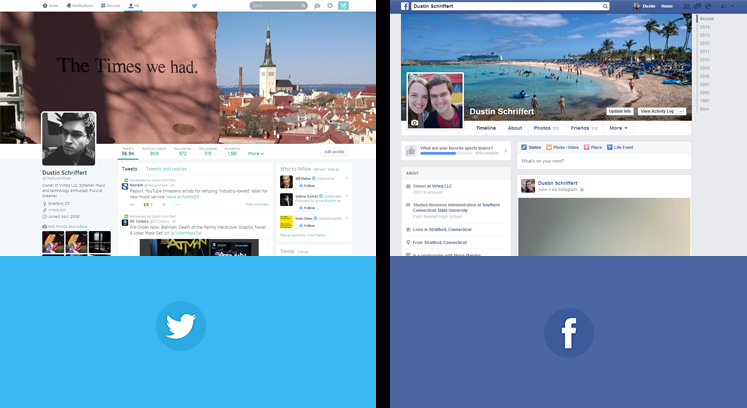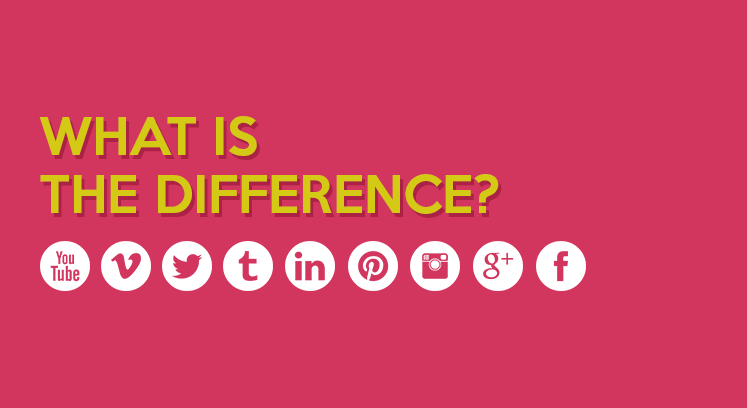The last few years have been some of the most socially interactive in human history thanks to innovative technologies that have laid the ground work for social media to explode throughout the Internet, on our phones, tablets, laptops, and even our glasses.
Social media is everywhere. By now, we’re all very familiar about what Twitter is. Kids are probably growing up thinking a tweet is a 140 character text, not a sound birds make. Babies swipe through magazines instead of turn pages. We consume media in a very different way.
So you’d think we all generally understand why we make both a Twitter account and a Facebook account, or a YouTube account and a Vimeo account, instead of just one.
It still surprises me how often I hear, “Twitter is better than Facebook. I don’t need Facebook because I have my Twitter account.” This sentence is like nails on a chalkboard. I’m shocked how many people cannot tell the difference between social networks, implying that they all do the same thing so there’s no reason to have an account on any more than just one of them.
Let’s talk about Twitter and Facebook, since those seem to be two extremely common and well-known services that seem to get mentioned the most, when it comes to how similar and different they are.
Twitter is like a global text message. It uses a stream of information that anyone can subscribe to. Facebook utilizes a stream of information, too, which anyone can subscribe. So you can see how people are quick to say they are practically the same thing. In that very general sense, this is true, but the way content reaches people is very different.
Facebook will allow you to post to your timeline, and those you befriended can read it, as well as anyone who stumbles upon your profile by searching your name (if your privacy settings allow it). This actually creates a more intimate reach. Your information will mostly reach those you know, and friends of those you know.
Twitter very quickly adopted hashtags, the use of a phrase used to track information posted about similar subjects. When people are looking for INFORMATION, they search Twitter. When people are looking for PEOPLE, they search Facebook.
Sure, you might find a person on Twitter, and you can find information on Facebook. But the processes we use to get to the end result are different, and information is displayed differently.

Twitter is very focused in its approach. We are looking to consume information in small bites of 140 characters or less. Facebook is used to find content that people post to their timeline, as well as photos, videos, and more using a presentation that displays information as if you are meant to read through it all. Because Twitter uses a vertical stream, in order to consume ALL of the information on the account, you’d have to scroll a LOT, which Twitter discourages. Surely, you can do so, but Twitter is mostly meant for staying in the moment and reading what appears in your stream at any moment in time, not reading on what has been posted in the past because that information is irrelevant now.
There are many social media websites that appear to have similar uses, but really they both serve a purpose that can be useful to you.
The moral of this story is that if you want the best experience online, there is nothing wrong with using multiple services. Forcing yourself to choose one over another only hurts your own experience. Consider the benefits of each network.
For example, many artists and activists use Vimeo because that’s the kind of audience it attracts. YouTube is looking for general audiences of all types looking for anything. Can both upload any video no matter what the content? Of course! But they approach their audience differently.
From a marketing perspective, it is useful to utilize accounts on multiple platforms. Not because people only have an account on one of the 5 major networks, but because people are looking for different things on different networks, and companies know they have fans/members/followers who have many different interests. It makes finding their content easier by going to each network, instead of assuming only one is really necessary for attracting the attention of their customers, users, etc..
Social networking is a very powerful tool in this day in age. It needs to be handled appropriately depending on the purpose, audience, and message. We use social media so much that we often forget the most effective ways to use them and sometimes generalize two or more networks as being “the same thing,” which couldn’t be farther from the truth.
Take this knowledge, think about how you’re using Twitter, Facebook, YouTube, Vimeo, Tumblr, Flickr, Google+, etc. and sign up for one if it intrigues you, and align your profiles, streams, timelines, and dashboards to reflect the intent of your usage. You’d be surprised at how the smallest differences can compound your influence and reach!
